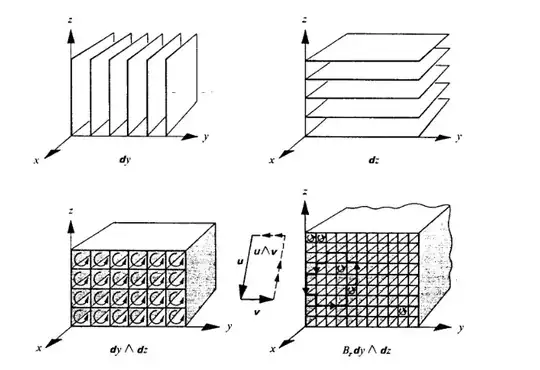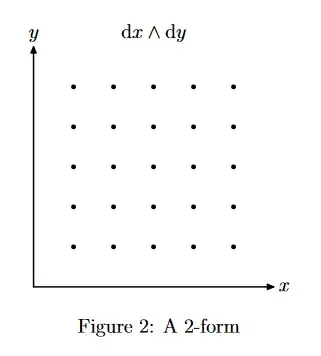I think I understood 1-forms fairly well with the help of these two sources. They are dual to vectors, so they measure them which can be visualized with planes the vectors pierce.
But I struggle with the explanations for higher order forms.
The goal is to answer and understand these questions with drawings:
- How can I visualize the wedge between two 1-forms $\alpha\wedge\beta$? I think I understood the wedge between two vectors, as the parallelogram created by the two in a "area sense". The determinant comes in to make it only about the area which is why $v\wedge w = \frac{1}{2}v\wedge 2w$ since stretching the parallelogram by two in the w direction is compensated by squishing it in the v direction, so the area stays constant. So the wedge between two vectors is the area it spans with its vectors. But how does that translate to the dual space? Where 1-forms measure the length of the component of its dual vector. And can be visualized as planes the vectors pierce through. What is the visualization between two of these 1-forms as a wedge?
Gravitation has this picture:
Now these pictures make some sense as they are generated by intersecting the 1-forms. But I am not quite getting how the result is evaluated. The result (2-form) should map two vectors as input to a number. And I don't see how these intersections do that. While for 1-forms you count the numbers of planes a vector pierced.
- Why does it make sense that $d(d\alpha)=0$ for every differential form $\alpha$
- What does Dan Piponi mean by saying: "exterior derivative is none other than finding the boundary of the picture" (4 Exterior Derivatives)
- Understand part 5 about Stokes' theorem from Dan Piponi's paper
Note: I should maybe add that I have no background in physics, so I didn't understand a lot of the stuff in Gravitation. I just tried to read it after I couldn't quite understand other source since it was cited there.
Similar questions:
What's the geometrical intuition behind differential forms?
Edit (since someone voted "close", based on this question as a duplicate): This question indicates not grasping how 1-forms work ("families of surfaces [...] Why do this interpretation makes any sense?") not only does that invite explanations for 1-forms and hand-waving away the rest with "it works similarly in higher dimensions" but it in particular does not mention specific visualizations for 2-forms which kind of show that there should be an intuition for 2-forms (and maybe higher). And while this question accepted an answer already, this answer does not help to answer the (enumerated) questions above. So this is absolutely not a duplicate.



